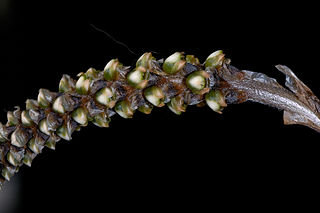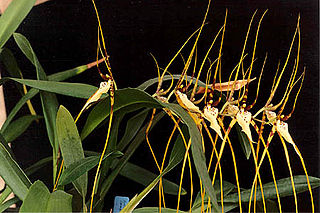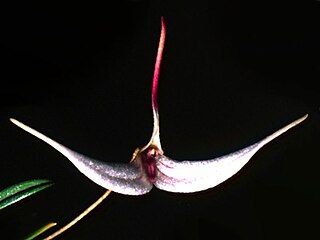
Aa is a genus of plants of the family Orchidaceae.

Stanhopea is a genus of the orchid family (Orchidaceae) from Central and South America. The abbreviation used in horticultural trade is Stan. The genus is named for the 4th Earl of Stanhope (1781-1855), president of the Medico-Botanical Society of London (1829-1837). It comprises 55 species and 5 natural hybrids. These epiphytic, but occasionally terrestrial orchids can be found in damp forests from Mexico to Trinidad to NW Argentina. Their ovate pseudobulbs carry from the top one long, plicate, elliptic leaf.

Oncidium, abbreviated as Onc. in the horticultural trade, is a genus that contains about 330 species of orchids from the subtribe Oncidiinae of the orchid family (Orchidaceae). As presently conceived, it is distributed across much of South America, Central America, Mexico and the West Indies, with one species (O. ensatum) extending into Florida. Common names for plants in this genus include dancing-lady orchid and golden shower orchid.

Brassia is a genus of orchids classified in the subtribe Oncidiinae. It is native to Mexico, Central America, the West Indies, and northern South America, with one species extending into Florida.
Schomburgkia was a genus of plants belonging to the family Orchidaceae. This genus was named for Richard Schomburgk, a German botanist who explored British Guiana during the 19th century. Former species of this genus were either epiphytic or lithophytic in their growth habit. According to the Royal Horticultural Society Schom. was the official abbreviation for this genus.

Barbosella is a genus of mostly creeping orchids. The genus has about 20 species, widespread across the West Indies and Latin America from Mexico and the Lesser Antilles to Argentina. Named after João Barbosa Rodrigues, an investigator of Brazilian orchids. They have solitary flowers with a unique lip base that works like a ball and socket.

Dryadella is a genus of miniature orchids, formerly included in the genus Masdevallia. Plants are typically composed of a tuft of leaves from 3 to 6 cm long. The small (1–2 cm) flowers are often conspicuously spotted, and are borne at the base of the leaves. There are about 60 species, distributed from southern Mexico to southern Brazil and northern Argentina. In cultivation many of the species seem to respond well to being grown on cork or treefern rather than in pots. The attractive species Dryadella edwallii, commonly known as 'Partridge in the Grass' can be easily grown into a spectacular specimen plant, full of flowers. The genus name of Dryadella refers to Dryad, a tree nymph or tree spirit in Greek mythology.

Kraenzlinella is a genus of flowering plants from the orchid family, Orchidaceae, first described as a genus in 1903. It is native to S Mexico, Central America, and South America.
- Kraenzlinella anfracta(Luer) Luer - Tolima region in Colombia
- Kraenzlinella echinocarpa(C.Schweinf.) Luer - Peru, Ecuador
- Kraenzlinella erinacea(Rchb.f.) Solano - Oaxaca, Chiapas, Central America, Colombia, Venezuela, Guyana, Ecuador, Peru, Bolivia
- Kraenzlinella gigantea(Lindl.) Luer - Peru
- Kraenzlinella hintonii(L.O.Williams) Solano - Guerrero
- Kraenzlinella lappago(Luer) Luer - El Oro + Napo Provinces in Ecuador
- Kraenzlinella phrynoglossa(Luer & Hirtz) Luer - Azuay Province in Ecuador
- Kraenzlinella rinkeiLuer - Costa Rica
- Kraenzlinella sigmoidea(Ames & C.Schweinf.) Luer - Costa Rica
- Kraenzlinella tunguraguae(F.Lehm. & Kraenzl.) Kuntze ex Engl. & Prantl - Colombia, Ecuador, Peru
- Kraenzlinella platyrachis(Rolfe) Rolfe = Specklinia pfavii(Rchb.f.) Pupulin & Karremans
- Kraenzlinella shuarii(Luer) Luer = Echinosepala shuarii(Luer) Luer
- Kraenzlinella smaragdina(Luer) Luer = Anathallis smaragdina(Luer) Pridgeon & M.W.Chase

Porroglossum is a genus of orchids native to the Andes of South America. The center of diversity lies in Ecuador, with many of the species endemic to that country, though others are found in Colombia, Venezuela, Peru, and Bolivia. This genus is abbreviated Prgm in horticultural trade.

Ponthieva is a genus in the orchid family (Orchidaceae), commonly known as the shadow witch. They are named after Henry de Ponthieu, an English merchant of Huguenot ancestry who sent West Indian plant collections to Sir Joseph Banks in 1778.
Teagueia is a genus of orchids. They are found at high altitudes in the Andes in Colombia, Peru and Ecuador.

Trichosalpinx, commonly known as the bonnet orchid, is a genus of about 100 species of neotropical orchid. The genus is widespread across most of Latin America from northern Mexico to Bolivia, as well as the West Indies.

Trisetella is a genus of orchids, native to Central and South America. Twelve of the 23 currently known species are endemic to Ecuador. They bear small flowers with fused sepals and fused petals. The synsepal bears three hair-like tails, which is the namesake of Trisetella.

Cycnoches, abbreviated as Cyc. in the horticultural trade, is a genus of 34 currently accepted species of orchids native to South America, Central America and southern Mexico. Also called "swan orchids", they are epiphytes found in lowland and pre-montane forests.

Rodriguezia, abbreviated Rdza. in the horticultural trade, is a genus of orchids. It consists of 49 known species, native to tropical America from southern Mexico and the Windward Islands south to Argentina, with many of the species endemic to Brazil.

Polycycnis, abbreviated in horticultural trade as Pcn, is a genus of orchid, comprising 17 species found in Central America, and northern South America.

Pterichis is a genus of flowering plants from the orchid family, Orchidaceae. It is native to South America, Central America and Jamaica.

Sarcoglottis is a genus of flowering plants from the orchid family, Orchidaceae. It is widespread across much of Latin America from Mexico to Argentina, with one species extending northward into Trinidad and the Windward Islands.
















